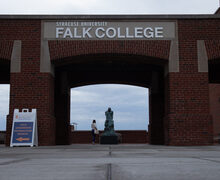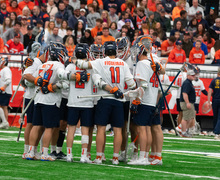Bridging invisible barriers: Activists encourage students to participate in local movements
Emma Folts | Managing Editor
Last summer, Last Chance for Change marched across the city for 40 days to protest police brutality in the city and across the country.
Get the latest Syracuse news delivered right to your inbox.
Subscribe to our newsletter here.
To Hasan Stephens, invisible barriers separate Syracuse University from the rest of the city.
Students are often disconnected from the realities of the world around them, and some don’t recognize the issues going on right outside their campus, said Stephens, the founder and executive director of the Good Life Youth Foundation, an organization that uses pop culture to mentor and support youth in Syracuse.
“Syracuse is a microcosm of the most marginalized populations in the United States, and (many students) still don’t quite know the realities that many people are going through,” Stephens said.
Local activists such as Stephens said that SU students should understand issues in the local community and be involved in fixing them. Greater involvement by students in the community would help shorten the divide between the university and the city, and it could also increase students’ cultural awareness around the problems city residents are facing, they said.
Curtis Chaplin, a member of Last Chance for Change, a local activist group that formed last summer in the wake of the murder of George Floyd, was one of the community members who participated in the #NotAgainSU protests.
“I wanted to let them know that we were behind them,” Chaplin said. “Even though this is a city separated by invisible lines of the campus and community, we would stand there and support them and be with them as well.”
To hold those in positions of power accountable, people from both the city and the campus community need to unify, Chaplin said. But there is often a disconnect between the city and campus, he said.
City residents are frustrated with the way SU has expanded into the greater Syracuse area, Chaplin said. Though they don’t blame the students at the university, there is a negative feeling toward SU, especially since the university is exempt from paying property taxes to the city, he said.

Coming into the community and engaging with activist groups such as Last Chance for Change can help SU students see what is going on beyond campus. Emma Folts | Managing Editor
Many residents have expressed concerns about the removal of the Interstate 81 viaduct, which could leave 18 acres of developable land in the city. They are worried that large entities like SU will build on the land, further displacing communities that were already destroyed when the highway went up.
“Unfortunately, people in the community often have a very sour taste and perspective of the university,” Stephens said. “I think that coming down and engaging in the population is a way in which people understand that students want to help, and students want to understand what’s going on.”
Some students don’t have a good understanding of what it’s like to grow up in Syracuse, Chaplin said. Many students at SU are more privileged than those living in Syracuse, but coming into the community and engaging with activist groups such as Last Chance for Change can help them see what is going on beyond campus, he said.
“We want them to know that we’re here. We’re living in the same city, but we’re not the demons and the savages and the thugs that we’re portrayed to be,” Chaplin said. “They’ve never had to go through some of the hardships that these kids have gone through, but it’s something to give to them so when they graduate maybe they might want to take part in helping out.”
Zahabu Gentille Rukera, an SU senior majoring in political science and communications and rhetorical studies with a minor in philosophy, said SU students should use what they are learning at the university to help the community. Rukera, who grew up in Syracuse, was involved in the #NotAgainSU movement and Last Chance for Change.
“I didn’t understand how corrupted and messed up the system was until I got into college,” Rukera said. “I feel like using your education to fight for what’s right is something that everyone should do.”
Having SU students advocate alongside Last Chance for Change or other groups, such as Rebirth SYR and the Syracuse Police Accountability and Reform Coalition, also draws more attention to the causes those groups are advocating for, Chaplin said.
Last summer, Last Chance for Change marched across the city for 40 days to protest police brutality in the city and across the country. It was also one of 15 activist groups to sign the People’s Agenda for Policing, a series of demands to reform the Syracuse Police Department that Mayor Ben Walsh partially agreed to in July.
If students who aren’t from Syracuse participate in protests and demonstrations, their parents or friends back home will see what they are doing and become more aware of what activist groups are fighting for, Chaplin said.
“It’s eyes outside of Syracuse that are now looking,” he said. “And the more eyes that are focused on Syracuse, the more questions that can be asked, and the closer we’re getting to a solution.”
Including students in activist movements also increases those movements’ presence, said Kayla Johnson, a member of Rebirth SYR. If Syracuse residents and students came together, the city will have no choice but to pay attention to what is happening, she said.
Rebirth SYR recently pledged to march for 40 days to honor and seek justice for Judson Albahm. Police officers from multiple agencies shot and killed Albahm, who was having a mental health crisis, after he allegedly pulled out a fake gun. He was 17 years old.
“Not only will it be us marching, it’ll also be the students on campus who aren’t even from here,” Johnson said. “It’ll let them know that even the students who aren’t from Syracuse, New York — even they see that it is a problem.”
But students should also get involved with the city beyond activism, local organizers said.
Clifford Ryan, a lifelong Syracuse resident, said that SU’s students can offer support and aid for the community. Ryan is the founder of OG’s Against Violence, an organization that works to decrease violence in the city by using violence intervention to break up fights and promote conflict resolution in the city.
Ryan is currently working to expand his organization to include training programs for more city residents who can help him confront violence in the city. Students can help him organize and promote the trainings once they start, he said.
“The relationship (between SU and the city) can improve with the university coming off the Hill, coming down into the community and engaging the community,” Ryan said.
Many students have also helped the Good Life Youth Foundation through tutoring programs and by providing legal and entrepreneurship advice for young people involved in the foundation, Stephens said.
Even though this is a city separated by invisible lines of the campus and community, we would stand there and support them and be with them as wellCurtis Chaplin, member of Last Chance for Change
When college students participate in tutoring and after school programs, young people feel valued and appreciated, Chaplin said.
Chaplin is a coach at Option Zero, a youth enrichment program that provides self-defense and life skills training for people between 4 and 12 years old. Having SU students involved in the program would help motivate kids and give them a sense of confidence.
“Leveraging Syracuse’s greatest asset, which are the students, would help the community understand that they’re not here to just take, but they’re here to give,” Stephens said.
SU students are as much a part of the community as local residents, said Dramar Felton, another organizer with Last Chance for Change. They have a strong voice in the city and need to use it to show that they support the community they live in, he said.
“You are a human that shows love and support to an environment that needs you, an environment that loves you the way they love themselves, an environment that needs something that you can show them,” Felton said. “You’re a student, (but) don’t ever forget in your eyes or your heart or your soul the purpose of you being a human being.”
Published on May 11, 2021 at 10:41 pm
Contact Maggie: [email protected] | @maggie_hickss





